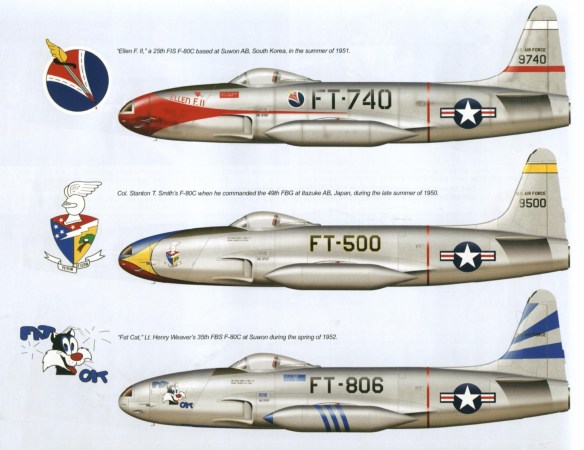
“The Shooting Star was possibly the best Allied jet fighter to emerge from World War II (called the P-80 until after WWII), however, like the other Allied jets it was too late to be used in combat. Several were flown around Italy late in the war, but they never saw the enemy.
The Shooting Star was the first mass-produced jet fighter in American history and the first to exceed 500 miles per hour in level flight. It later fought well in Korea and won the first jet-to-jet battle in history.
With the failure of Bell’s P-59 Airacomet to perform as expected, the Army Air Force approached Lockheed to design a new aircraft around the British H1 turbojet engine. A team led by Clarence “Kelly” Johnson completed the task in only 143 days, and the prototype XP-80 first flew in January 1944. The design was launched in June 1943 using the de Havilland H.1B turbojet. The new craft was a streamlined, low-wing monoplane with retractable landing gear and a bubble canopy. It exceeded 500 miles per hour on its first flight, and the Army authorized a production order for 5,000 machines as quickly as possible. The power plant was soon changed to the Allison turbojet. This aircraft was a sleek, low-wing monoplane with tricycle landing gear and all round canopy visibility. The P-80 version with an improved wing, began to enter service in January 1945, and a total of just 45 of this variant had been delivered before the end of the war. However, World War II ended before the P-80 could be committed to battle, and orders were scaled back to only 917 planes. Nonetheless, the Shooting Star was America’s introduction to the jet age, and during the next five years it became the most numerous fighter in the newly created U.S. Air Force. A total of 1,714 were built.
In 1948 the Air Force dropped the designation “P” for ‘‘Pursuit” in favor of “F” for “Fighter.” When the Korean War broke out in 1950, F-80s were on hand in Japan and rushed to the scene of combat. On June 27, 1950, a Shooting Star of the 35th Fighter Squadron scored the first American jet victory by downing two IL10 bombers over South Korea. Then, on November 8, 1950, an F-80 engaged and shot down a Russian-built MiG15 in the first clash between rival jet fighters. However, as the F-80s were badly outclassed by sweptwing aircraft, they were eventually withdrawn from frontline service and served as fighter-bombers. After the war they were gradually replaced by more modern types.
Technical Details
The F-80 was designed as a single seat fighter. The engine of the F-80B was the Allison J33-A-21 turbojet with 4,000 lb (2,041 kg) of thrust. Maximum speed was 577 mph (967 km/h) at 6,000 ft (1,830 m). It was armed with the American standard six .50 caliber machine guns in the nose of the aircraft. It was capable of carrying two 1,000 lb bombs on the wings or wing-mounted, disposable fuel tanks.”